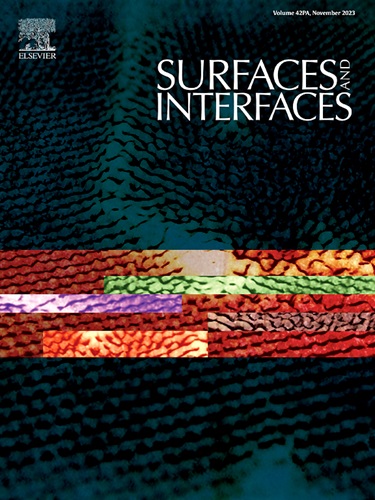Efficient photocatalytic hydrogen evolution: synergistic triple heterojunctions based on ZnIn2S4, Co3O4 and SiC@g-C3N5
IF 5.7
2区 材料科学
Q2 CHEMISTRY, PHYSICAL
引用次数: 0
Abstract
The production of hydrogen through photocatalytic technology has become a very attractive way to alleviate the problem of environmental pollution. In this work, A ZnIn2S4![]() Co3O4-(SiC@g-C3N5) triple heterojunctions structure was constructed. In this structure, a P-N heterojunction is formed by Co3O4 with ZIS, a Z-type heterojunction is constructed by ZIS with CN5, and a II-type heterojunction is formed by CN5 with SiC. The three are synergistically used to optimize the carrier migration path. Under this synergistic mechanism, Co3O4 increases the concentration of photogenerated electrons in the ZIS conduction band. It allows the photogenerated electrons to participate in the H⁺ reduction hydrogen generation reaction. Meanwhile, SiC facilitates further electron enrichment in the CN5 conduction band via the type - II heterojunction.SiC also boosts carrier migration efficiency through the Z - type pathway. In the ZnIn2S4 - Co3O4-(SiC@g - C3N5) system, the consumption rate of useless photogenerated electron - hole pairs per unit time is much higher than that in the ZIS - CN5 system with only one Z - type heterojunction. The number of photogenerated electrons on ZIS in the ZnIn2S4 - Co3O4-(SiC@g - C3N5) system is much higher than that in the ZIS - CN5 system. This greatly reduces the probability of the system's photogenerated carrier complexation. It also increases the charge separation efficiency. As a result, the photocatalytic efficiency is significantly improved. 20ZIS-Co-(SiC@CN5) composites exhibited efficient hydrogen production (13655μmol·g-1-h-1) in hydrogen production experiments. The ZIS - Co - (SiC@CN5) composites enable efficient separation and directional migration of photogenerated carriers via the collaborative action of the multilevel heterojunction. This action offers a scalable concept for designing highly efficient and stable photocatalysts for hydrogen production.
Co3O4-(SiC@g-C3N5) triple heterojunctions structure was constructed. In this structure, a P-N heterojunction is formed by Co3O4 with ZIS, a Z-type heterojunction is constructed by ZIS with CN5, and a II-type heterojunction is formed by CN5 with SiC. The three are synergistically used to optimize the carrier migration path. Under this synergistic mechanism, Co3O4 increases the concentration of photogenerated electrons in the ZIS conduction band. It allows the photogenerated electrons to participate in the H⁺ reduction hydrogen generation reaction. Meanwhile, SiC facilitates further electron enrichment in the CN5 conduction band via the type - II heterojunction.SiC also boosts carrier migration efficiency through the Z - type pathway. In the ZnIn2S4 - Co3O4-(SiC@g - C3N5) system, the consumption rate of useless photogenerated electron - hole pairs per unit time is much higher than that in the ZIS - CN5 system with only one Z - type heterojunction. The number of photogenerated electrons on ZIS in the ZnIn2S4 - Co3O4-(SiC@g - C3N5) system is much higher than that in the ZIS - CN5 system. This greatly reduces the probability of the system's photogenerated carrier complexation. It also increases the charge separation efficiency. As a result, the photocatalytic efficiency is significantly improved. 20ZIS-Co-(SiC@CN5) composites exhibited efficient hydrogen production (13655μmol·g-1-h-1) in hydrogen production experiments. The ZIS - Co - (SiC@CN5) composites enable efficient separation and directional migration of photogenerated carriers via the collaborative action of the multilevel heterojunction. This action offers a scalable concept for designing highly efficient and stable photocatalysts for hydrogen production.
高效光催化析氢:基于ZnIn2S4, Co3O4和SiC@g-C3N5的协同三重异质结
光催化制氢技术已成为缓解环境污染问题的一种极具吸引力的途径。本文构建了一种ZnIn2S4Co3O4-(SiC@g-C3N5)三重异质结结构。在该结构中,Co3O4与ZIS形成P-N异质结,ZIS与CN5形成z型异质结,CN5与SiC形成ii型异质结。这三者协同用于优化载波迁移路径。在这种协同机制下,Co3O4增加了ZIS导带中光生电子的浓度。它允许光生电子参与H +还原制氢反应。同时,SiC通过II型异质结促进了CN5导带中的电子进一步富集。SiC还通过Z型途径提高载流子迁移效率。在ZnIn2S4 - Co3O4-(SiC@g - C3N5)体系中,单位时间内无用光生电子空穴对的消耗率远高于只有一个Z型异质结的ZIS - CN5体系。ZnIn2S4 - Co3O4-(SiC@g - C3N5)体系中ZIS上的光生电子数远高于ZIS - CN5体系。这大大降低了系统光生成载流子络合的概率。它还提高了电荷分离效率。因此,光催化效率显著提高。20ZIS-Co-(SiC@CN5)复合材料产氢效率达到13655μmol·g-1-h-1。ZIS - Co - (SiC@CN5)复合材料通过多层异质结的协同作用实现了光生载流子的有效分离和定向迁移。这为设计高效稳定的制氢光催化剂提供了一个可扩展的概念。
本文章由计算机程序翻译,如有差异,请以英文原文为准。
求助全文
约1分钟内获得全文
求助全文
来源期刊

Surfaces and Interfaces
Chemistry-General Chemistry
CiteScore
8.50
自引率
6.50%
发文量
753
审稿时长
35 days
期刊介绍:
The aim of the journal is to provide a respectful outlet for ''sound science'' papers in all research areas on surfaces and interfaces. We define sound science papers as papers that describe new and well-executed research, but that do not necessarily provide brand new insights or are merely a description of research results.
Surfaces and Interfaces publishes research papers in all fields of surface science which may not always find the right home on first submission to our Elsevier sister journals (Applied Surface, Surface and Coatings Technology, Thin Solid Films)
 求助内容:
求助内容: 应助结果提醒方式:
应助结果提醒方式:


